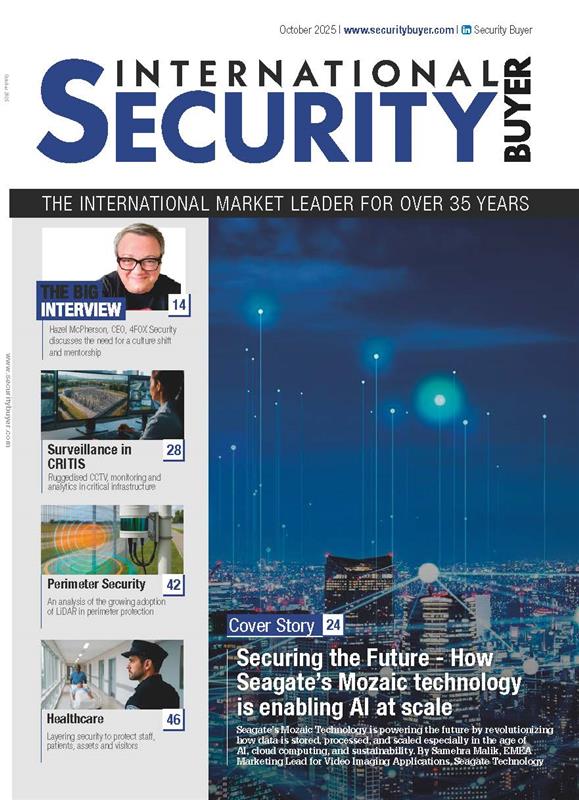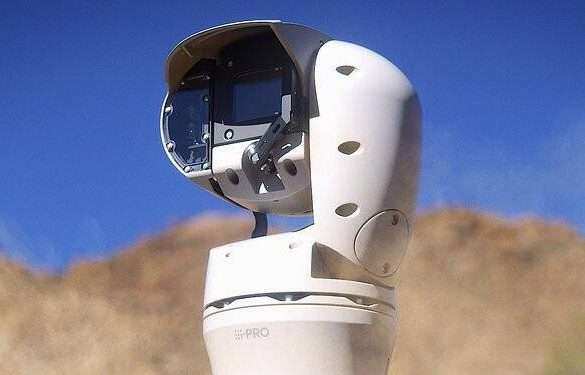Floating on air – Aerostats making their mark
Tim Compston finds out why aerostats are making their mark in the on-going battle to thwart drug smugglers on land and sea and to secure borders and critical infrastructure from a wide array of threats.
Although drones are very much in the news at the moment, aerostats are one family of aerial systems which have much to commend them. Certainly the ability to deliver a persistent overview of areas, for days or even weeks at a time, from thousands of feet above the surrounding landscape make aerostats stand out from the crowd.
The resurgence of aerostat systems, at a tactical and strategic level, in recent years can, in part, be put down to the way that they have been rolled out to great effect by the US military in both Iraq and Afghanistan, with many of these battle-proven units, now surplus to requirements, being trialled and deployed by other government agencies for non-military applications.
Turning to the thoughts of a leading vendor, Dr Robert Smith, Lockheed Martin’s vice president of C4ISR, points out that as the US brings back its complement of aerostats from theatre, re-using them for other military and civilian applications is an excellent way of leveraging existing capital assets. On a wider note he is keen to reiterate what aerostats add to the border protection equation:
“With the capability to provide panoramic day/night surveillance in extremely challenging weather, aerostats have shown themselves to be very successful in supporting border protection efforts.” Dr Smith confirms that Lockheed Martin is actively involved in discussions with a number of domestic and international customers regarding future aerostat deployments.

An enduring view
Dr Smith stresses that aerostats support a 24/7 surveillance capability that simply isn’t possible with manned and unmanned aircraft which face ‘surveillance time limitations’ dictated by fuel consumption and payload. Touching on how aerostat technology has changed in recent years, Dr Smith reports that the biggest advances centre on sensors and payloads: “Our LM 74K aerostat system, for example, is modular and can support up to five different payloads plus multiple communication assets.” On the distinction between tactical and strategic aerostat systems, Dr Smith says it basically comes down to size: “The larger class aerostats fly higher and carry significantly heavier, more capable, sensors.”
Craig Laws, senior product manager at Raven Aerostar, another aerostat manufacturer with a strong track record here, is in agreement over the gains aerostats can deliver on the operational front: “For any kind of sensor you would put on a tower, you would like to have higher, an aerostat is a good option.”
Laws adds that the same holds true for sensors you might like to deploy on an aircraft or UAV but want to keep airborne for as long as possible:
“With aerostats you don’t really have to fuel them you just need to make sure that you have lifting gas [usually helium].”
Questioning the mission
When assessing which aerostat meets a particular customer’s mission requirements, Laws advises that comes down to what the end user actually wants to monitor: “Do they need a camera? Do they need radar? Do they need both? Do they want to put a communications relay on-board as well? Once we can build that payload package it allows us to size the aerostat as payload weight is the most critical factor.”
Advances in sensor technology, says Laws, are also helping to keep a lid on payload weight so there is the option to downsize the aerostat, stay aloft longer, or fly higher: “You can get almost the same performance out of a 10 inch [camera] gimbal as a 15 inch gimbal a few years ago.” Another factor, adds Laws, is what altitude you want the aerostat to fly: “We typically fly up to 3,000 feet AGL [Above Ground Level] and our larger aerostats can go up to 6,000 feet.”
In terms of Raven Aerostar’s aerostat offering, Laws reveals that it ranges across ‘tactical’, ‘responsive’ and ‘enduring’. For smaller ‘tactical’ systems, Laws explains, the benefit is mobility:
“They are great because they are small. You don’t need to carry great quantities of helium with you. You can put them in the back of a truck, take them where you want and inflate them without a large logistics team – probably two to three people are sufficient.”
Laws adds that, on balance, it is the mid-range ‘responsive’ systems which are the most versatile: “They are a great match for current technology. Our 25,000 cubic feet balloon is a workhorse with a payload normally around 300 pounds and for practical purposes you can put a small radar and a 15 inch camera on that. This is the model we sent to Afghanistan back in 2010/2011.”
Regarding the endurance that aerostats offer, Laws replies that, normally, for a mid-range aerostat you are looking in the region of 14 days, and 30 days for larger models – the so-called ‘enduring’ aerostats: “We call these enduring because once you build the infrastructure they are more of a long-term strategic fixture.”
Border protection
One individual who has his finger on the pulse of larger, strategic, aerostats is Rob Brown, programme manager at U.S. Customs and Border Protection (CBP). Brown has responsibility for the long-serving tethered aerostat radar system, or TARS for short. TARS units stretch over the southern U.S. border at 10,000 feet from Yuma, Arizona, to Lajas, Puerto Rico: “The aerostats are aerodynamic balloons and fly like kites in the wind,” says Brown. He reveals that the eight special TARS units recently transferred over from the Department of Defence to the Department of Homeland Security, under whose umbrella CBP falls.
The beauty of TARS, according to Brown, is the opportunity to use a powerful 200 mile range radar to pick-up light aircraft which are frequently employed in drug smuggling and other nefarious activities: “The fleet of TARS have been in operation for over a quarter of a century along the South-west border, South Florida and even parts of the Caribbean.” Brown says that their primary mission is to detect and monitor airspace:
“With TARS we are looking and sorting through hundreds of aircraft a day and trying to help our law enforcement officers identify what might be suspicious. They are then able to launch further action against any suspicious activity in the form of an investigation or an actual interdiction of the aircraft.”
Drug busting
The origins of the CBP aerostat programme can be traced all the way back to when the U.S. Customs Service started using tethered aerostats to counter the rising number of low-flying aircraft operated by drug smugglers. It was estimated by customs authorities that, by the early 1980s, as many as 8,500 illegal flights per year were transporting narcotics directly from the Caribbean, Central or South America into the U.S. The drug smugglers modus operandi was to employ low-flying aircraft, using the terrain to their advantage making it difficult for ground based radar to pick them up. Placing radar in aerostats has proved to be a game changer here as previously elusive aircraft were now detectable. Today the number of unidentified aircraft flying across the border has dwindled, reports CBP, to around 10 per year, a far cry from the thousands before.
Brown contrasts the sheer scale of the TARS fleet with the more compact tactical aerostat solutions that have been transferred from the Department of Defence following their tasking by ground forces in Afghanistan: “They [TARS] are at least two times higher and five times bigger. They carry a ton of equipment as opposed to the smaller systems that lift a couple of hundred pounds.” Asked if the experience with TARS has helped with the roll-out of these tactical systems, Brown responds in the affirmative: “There is certainly some relationship between the strategic TARS and the tactical aerostats around the common support infrastructure that we able to capitalise on. The contractors that we deal with are pretty much the same, so there is synergy in our programme management activities.” However Brown acknowledges that the strategic (TARS) and tactical aerostats are focused on two distinct missions:
“You have one where the technology is orientated very much to a short range ground target, versus the other [TARS] where the focus is on long range aircraft target detection.”

Testing times
For an insight into the trials being conducted with smaller aerostats for border protection roles I caught up with Tobin Ruff, deputy director for operations, observation and analysis, at CBP: “We are responsible for putting the tactical aerostats in various AORs (Areas of Operation) over Southern Texas, specifically the Rio Grande valley. We did an initial 22-day test in the late summer of 2012 and about a year later deployed the first array close to the border with 500 to 1,000 feet versions of the aerostats. According to Ruff, South Texas is a highly forested area:
“Most of our situational systems are line-of-sight dependent where elevation provides you with a much better range. Using aerostats you get a bird’s eye perspective to see groups crossing within certain areas.”
Spotlighting the types of surveillance technologies carried by the tactical aerostats, Ruff says that the cameras are Electro Optical [EO] and Infra-red [IR] to provide day and night coverage: “The range varies but the ones we use on our aerostats have fairly decent reach both to the ground and at distance.”
The CBP’s tactical aerostats fall into three types, explains Ruff, with the initial set-up featuring two Rapid Aerostat Initial Deployment (RAID) models: “These are the smaller 17 and 22 metre systems and are closer to the border” Subsequently two Persistent Ground Surveillance System (PGSS) models were added. More recently CBP started flying even larger systems such as the Persistent Threat Detection System: “Right now we are up to five [aerostat] sites,” confirms Ruff.
In terms of monitoring what is going on, Ruff explains that each aerostat has a dedicated control station close to where it is tethered: “As we are evaluating the efficiency of these systems [aerostats] we haven’t integrated multiple systems into one display yet.” Questioned on the ability to move the aerostats to new hotspots, Ruff responds that the smaller tactical systems are all re-deployable: “It just takes a couple of 18-wheeler trucks.” An important attribute of these tactical systems is, reckons Ruff, the ability to reconfigure them to face-up to a changing threat situation on the ground.
So what has been the impact of these tactical aerostats? Well, to date, Ruff estimates that an impressive 40 tons of narcotics have been removed from circulation:
“The detection and apprehension numbers compared to historical levels have in some cases doubled and even trebled. Those are the sort of numbers that makes us encouraged that these systems are having an impact.”
The aerostat advantage
The clear message is that aerostats have demonstrated their worth when it comes to detecting suspicious activity in and around borders and pushing back against drug smuggling on the land, in the air, and at sea. For agencies that may have dismissed aerostats out of hand in the past, or perhaps never even considered them, perhaps now is good time for a reassessment of what tactical and strategic aerostats can actually offer.
[su_button url=”https://www.securitynewsdesk.com/newspaper/” target=”blank” style=”flat” background=”#df2027″ color=”#ffffff” size=”10″ radius=”0″ icon=”icon: arrow-circle-right”]To read the SecurityNewsDesk Newspaper click here[/su_button]

























